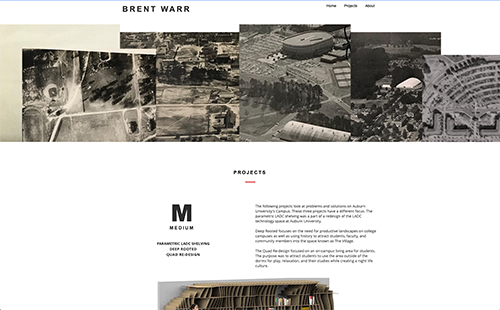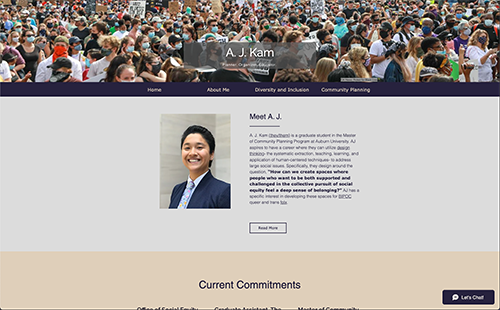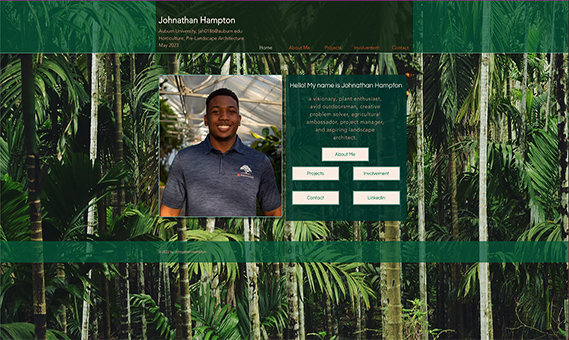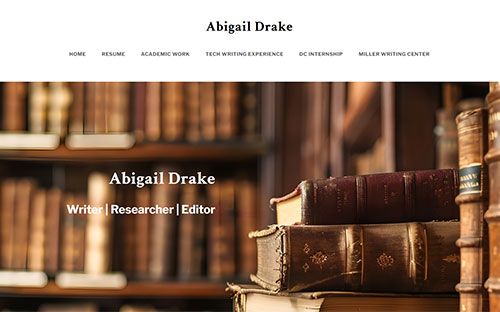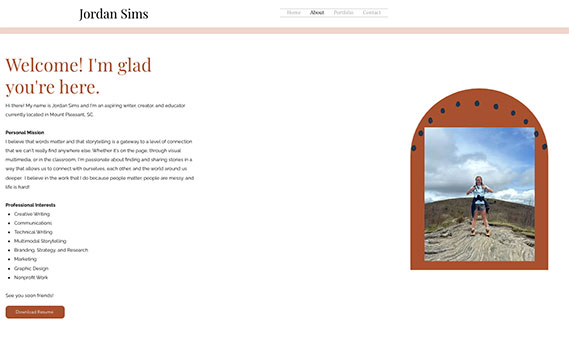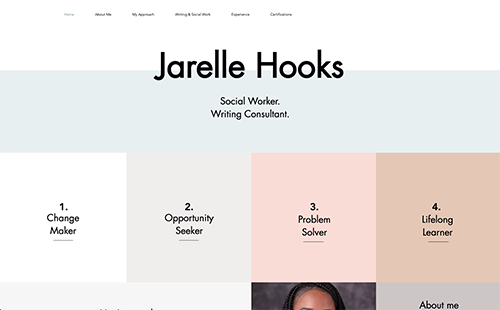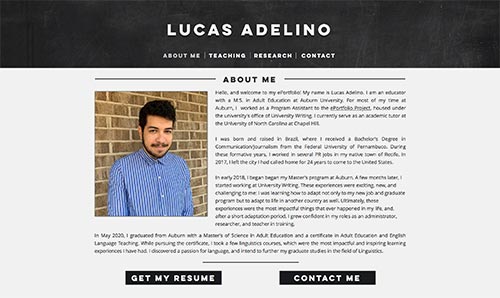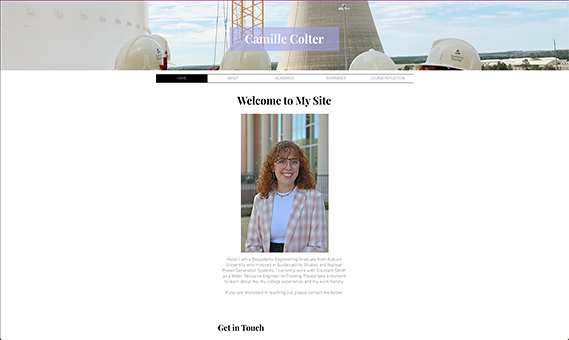Tagged Entries: Reflection
Academic writing is a unique type of writing and can vary across disciplines. Use these materials to better understand the elements of academic writing, such as voice, disciplinary writing, and college-level writing. Reading academic sources is an important part of learning how to write in your discipline. For tips on how to engage with reading these sources, see our section on Reading Difficult Materials
Materials designed by Colby Axelberd, Christopher Basgier, Katharine Brown, Amy Cicchino, Clare Hancock, Megan Haskins, James Truman, and Livi Welch
This worksheet is designed to help incoming first-year college students learn a bit about writing at the college level. There are also scenarios where students can consider what they would do in difficult writing situations
The handout breaks down some implicit expectations related to academic voice, such as when and how to use first-person writing, jargon, style, and sentence variation
This worksheet invites you to revise a piece of writing by paying attention to its voice within a sample paragraph
This brief handout provides some examples of academic voice from various disciplines
This worksheet provides excerpts from disciplinary writing and asks participants to guess the disciplinary context for the writing. By doing this, we hope you will begin to see how different disciplines structure and style their writing
This worksheet invites writers to consider the rhetorical situation of a genre and plan their writing within that genre
This worksheet helps you apply reading like a writer to your work by inviting you to examine written artifacts from a writerly perspective by paying attention to features like structure, key terms, signposting, and verb use
This worksheet is meant to help graduate students approach writing their first manuscript by making explicit options for manuscript section organization and looking at examples
This handout invites readers to compare an excerpt from a dissertation to an excerpt of the same material, rewritten for nonspecialist or "general" audiences
This handout invites extension professionals to reflect on the kinds of academic and non-academic genres the produce in their positions.
This worksheet invites writers to plan a piece of writing for a general audience by leading them through the elements of the rhetorical situation
This handout introduces person-centered language and demonstrates how it can be used to foster effective writing.
-
Using Person-Centered Language to Support Effective Writing Word Document
-
Using Person-Centered Language to Support Effective Writing PDF
This worksheet guides you through developing an argument and countering opposing arguments with a focus on claims, reasoning, and impact
This resource provides helpful information for students writing in a foreign language. Though writing in another language comes with its obstacles, it also yields many benefits that can lead to deeper learning and an elevated relationship with language
-
Writing in Another Language as an English First Language Speaker Word Document
-
Writing in Another Language as an English First Language Speaker PDF
This worksheet is designed to help you reflect on the kind of critical thinking you value in your teaching. It will guide you to articulate the ways your discipline frames inquiry, evidence, and judgment—so you can clarify those expectations for students. The specific dimensions of critical thinking below are adapted from Critical Thinking and Language by Tim John Moore
Large writing projects, such as dissertations, theses, and research papers, can be daunting. Use these resources to assist you with organizational and time management strategies needed to finish your project. Be sure to see our resources on The Writing Process as you engage in this work.
Materials designed by G. Travis Adams, Katharine Brown, Amy Cicchino, Abby Gibbons, Megan Haskins, Souji Gopalakrishna Pillai, Annie Small, and James Truman
This handout provides strategies for approaching large writing projects
This worksheet has tips and reflective questions to help you begin a large writing project
This worksheet introduces you to and helps you begin creating writing goals that are specific, measurable, attainable, relevant, and time-bound.
This handout offers you strategies to developing a regular writing routine
This handout shares strategies for tracking your writing progress, like wordcount trackers, accountability logs, and goal planning
This resource explains the Pomodoro Technique as a time management method where individuals work in focused intervals, usually 25 minutes, followed by a five-minute break. It emphasizes how this technique can help manage large projects by breaking them into smaller, more manageable tasks, ultimately boosting productivity and preventing burnout
This handout invites writers to reflect on their academic identity, celebrate writing successes, and plan their next steps in their large writing project
This brief writing prompt helps writers plan how to use their time productively in a writing session
This worksheet provides two brief writing prompts to use as a warm-up as well as recognize and celebrate moments of growth in writing skills
This writing warm-up encourages writers to affirm their readiness for writing through identifying the strengths they bring to the project
This writing warm-up invites writers to reflect on a semester's worth of writing and recognize moments of growth
This resource gives tips for starting the dissertation process while supporting mental, physical, and emotional health throughout
This resource provides tips to maximize writing efficiency while maintaining personal wellbeing during the dissertation process
The writing process can be stressful, and it is easy to feel anxious about writing, struggle to start writing, or lose focus while writing. Use these resources to implement mindfulness strategies such as meditative pauses, progress tracking, and reflective journaling into your writing routine.
Materials designed by G. Travis Adams, Christopher Basgier, Katharine Brown, Michael Cook, Gina Lamka, and Annie Small
This brief handout describes writer’s block and explains its causes
This brief worksheet explains solutions to writer’s block and a short reflective writing prompts to help you begin overcoming your own writer’s block
This is a handout useful for instructors as they help students navigate writer's block
This longer worksheet explains some of the causes of writer’s block and writing anxiety, and it offers reflective prompts you can use to manage writing challenges
-
Using Reflection to Manage Writer’s Block and Writing Anxiety Word Document
-
Using Reflection to Manage Writer’s Block and Writing Anxiety PDF
This handout describes the meditative pause, or brief moments in which you deliberately stop writing and check in with your body, your breath, and your mind, before returning to write
The following meditation script, “Focus into Breathing,” can be used before you write as a way of slowing down a busy mind and focusing attention
This activity helps you recognize your patterns of thought about writing and replace self-defeating thoughts with empowering ones to reduce the occurrence of writer’s block and writing anxiety
This activity combines Cognitive Behavioral Therapy (CBT) and contemplative and embodied pedagogies to help writers externalize and silence an overly harsh inner critic
This brief writing prompt helps writers plan how to use their time productively in a writing session
This worksheet guides you in using expressive writing for self-discovery. You will learn about different types of expressive writing, such as answering prompts or making gratitude lists, and can complete several reflective prompts.
This worksheet provides two brief writing prompts to use as a warm-up as well as to recognize and celebrate moments of growth in writing skills
This writing warm-up encourages writers to affirm their readiness for writing through identifying the strengths they bring to the project
This writing warm-up invites writers to reflect on a semester's worth of writing and recognize moments of growth
This handout discusses the emotional response writers may experience when their writing receives difficult feedback or is rejected for publication. It frames writers' emotions as having an evolutionary purpose and encourages writers to see feedback as a learning opportunity
Your personal brand is a representation of your work that tells your professional story. Taking time to reflect on and develop your personal brand can help employers, review committees, and graduate schools know who you are, what you do, and what you value. The resources below will introduce you to personal brand and help you begin to develop a personal brand statement.
Materials designed by Amy Cicchino, Layli Miron, Megan Haskins, and Lauren Schlosser
This handout explains what personal brand is and why it matters
Once you’ve reviewed the Personal Brand Handout above, use this worksheet to help you begin drafting your personal brand statement
This handout moves to a larger scale, aiding in the creation of mission and vision statements focused towards student organizations
This worksheet helps faculty and staff consider their professional brand and develop a brand statement
Personal statements are often part of the application process for prestigious scholarships and graduate or professional school applications. Use these resources to identify your goals and the expectations of your audience so that you can craft an effective personal statement. If you are applying for a Fulbright grant, please also see our resources specific to Fulbright.
Materials designed by Katharine Brown, Emily Cosgrove, Annie Small, and James Truman
This toolkit introduces personal statements and offers step for producing an effective personal statement
This worksheet will guide you in analyzing an example personal statement
These open response questions will help you brainstorm and pre-write for your personal statement
Once you have brainstormed, this worksheet will help you outline your personal statement
This worksheet will help you reflect and self-assess a personal statement draft to consider opportunities for revision
Reflective writing helps you critically think about your learning, respond to new knowledge, connect your learning experiences, and consider how new knowledge aligns to your professional and developmental goals. Use the resources below to learn more about reflective writing, including how to design reflective writing prompts.
Materials designed by Animal Sciences Academy Team, Christopher Basgier, Lindsay Doukopolous, ePortfolio Project, Souji Gopalakrishna Pillai, Margaret Marshall, Amber Simpson, Heather Stuart, and Parker Wade
This handout provides a brief introduction to reflective writing along with sample questions that can support reflective thinking
This handout introduces you to the six Rs of reflection: reporting, responding, relating, reasoning, reconstructing, and repackaging. Bain, J., Ballantyne, R., Mills, C. & Lester, N. (2002) labeled these levels with the mnemonic “5 Rs of reflection.” We have added a sixth level to this framework to account for the way reflection moves into other genres, such as an ePortfolio or personal narrative
This handout will take you through a heuristic process aimed at developing an effective reflective writing assignment for students keeping in mind the expected learning outcomes
-
A Heuristic for Developing a Reflective Writing Assignment Word Document
-
A Heuristic for Developing a Reflective Writing Assignment PDF
Reflection can take many different forms, and any number of strategies can help you support students’ reflective practices. This handout lists various prompts and questions you can adapt to your specific course context and objectives
This handout is meant to inform you on the benefits of using reflective writing in lab contexts
-
Assigning Reflective Writing Prompts in Lab Settings Handout Word Document
-
Assigning Reflective Writing Prompts in Lab Settings Handout PDF
This worksheet guides you in using expressive writing for self-discovery. You will learn about different types of expressive writing, such as answering prompts or making gratitude lists, and can complete several reflective prompts.
This handout gives three example reflective writing assignments from different disciplines, each fostering a different goal related to reflective practice
This worksheet will help you consider questions that are important as you develop a reflective writing prompt for your course
Once you’ve developed your reflective writing prompt, this peer reviewguide can help you get feedback.
-
Peer Feedback on Reflective Writing Prompts (for Faculty) Word Document
-
Peer Feedback on Reflective Writing Prompts (for Faculty) PDF
This worksheet provides examples of student reflections in need of feedback and guidance which you can use to practice providing feedback that helps students improve their reflective writing
This rubric was created as part of our ePortfolio Project. However, you can use or adapt it to assess reflective writing in ePortfolios
This worksheet guides writers through a structured process of reflecting on their writing before, during, and after completing a project to maximize their learning
A successful writing group can help you take personal accountability for your writing progress and give you a support network of other writers. Writing groups can help you create a writing routine, give and receive feedback on your writing, and help you talk through writing blocks.
Materials designed by Katharine Brown, Amy Cicchino, Megan Haskins, Margaret Marshall, and Annie Small
This handout will introduce you to writing groups and offer some considerations for you as you organize your own writing group
This worksheet introduces you to and helps you begin creating writing goals that are specific, measurable, attainable, relevant, and time-bound
This handout offers you strategies to developing a regular writing routine
This handout shares strategies for tracking your writing progress, like wordcount trackers, accountability logs, and goal planning
This worksheet can help your writing group determine what progress looks like for you and track that progress.
This reflective, discussion-based activity invites writers to evaluate their growth and discuss with group members areas of desired growth
This group conversation starter invites each group member to identify one writing skill of which they are proud and share it with the group
This activity invites writing groups to compose a letter to each other sharing how the writing group has been of support
Writing-to-learn activities are low-stakes writing prompts that help students engage with content knowledge, think critically, and practice applying their learning. Use the resources below to learn more about writing-to-learn and how it might play a role in your course.
Materials designed by Christopher Basgier, Alyssa Pratt, and Djibo Zanzot
This worksheet is designed to help you understand some of the features of an effective writing-to-learn (WTL) prompt. Remember that these features are not necessarily a checklist: some prompts will include and exclude different features depending on what is appropriate for your course and field
-
Features of Effective Writing-to-Learn Prompts Worksheet Word Document
-
Features of Effective Writing-to-Learn Prompts Worksheet PDF
This handout includes a range of writing assignments and activities you can ask students to complete in your course in order to promote their learning. Many of these assignments can have high stakes or low stakes versions
This worksheet will help you identify and define a difficult concept, and then map different levels of understanding for that concept. You can use these definitions as a basis for crafting your writing-to-learn assignments
Artifacts show evidence of your experiences, knowledge, and skills and can be anything: videos, photos, internship experiences, study abroad experiences, research posters, and course projects. You’ll want to contextualize your artifacts with reflective writing, which can connect your specific artifacts to your larger professional goals and personal brand.
Materials designed by Amber Simpson, Heather Stuart, and Parker Wade.
This handout offers examples of artifacts that you might potentially include in your ePortfolio. Remember, artifacts can be any kind of media
This worksheet will help you brainstorm artifacts and connect your artifacts to the skills that you are trying to showcase
Reflective writing allows you to articulate why an experience is important, what you learned during the process, and how you plan to apply your skills to future projects or endeavors. This handout gives you questions that you can use to begin drafting reflective writing for artifacts in your ePortfolio
This worksheet will guide you in drafting reflective writing for an artifacts in your ePortfolio
You can see how students at Auburn share and contextualize their artifacts by visiting our ePortfolio gallery
Below are links to ePortfolios from Auburn University students and alumni. Here you will find a variety of ePortfolios that include thoughtful reflections and relevant artifacts that showcase student learning to audiences outside the University.





